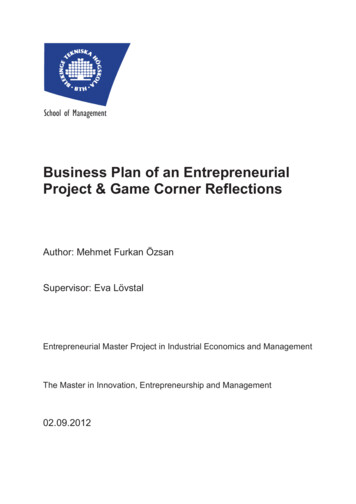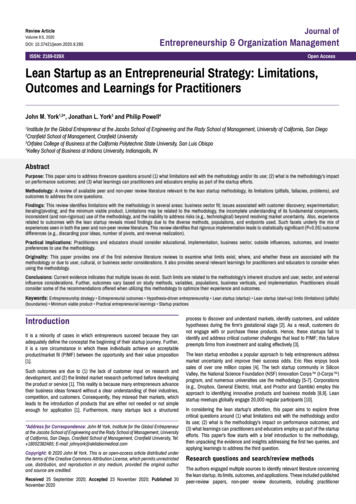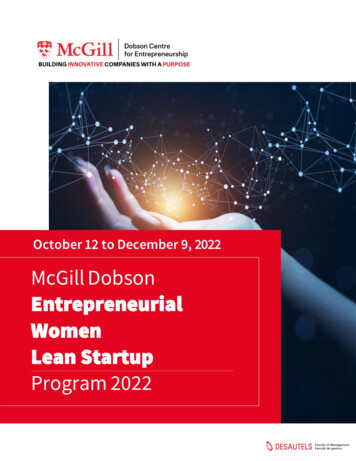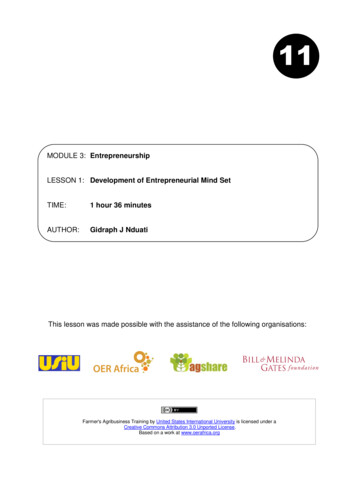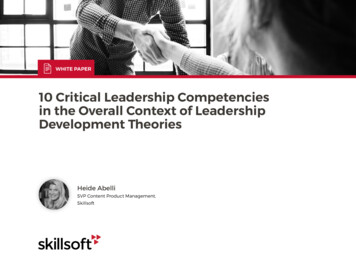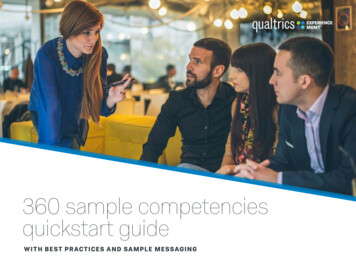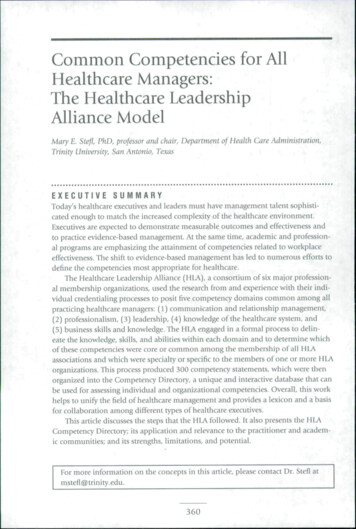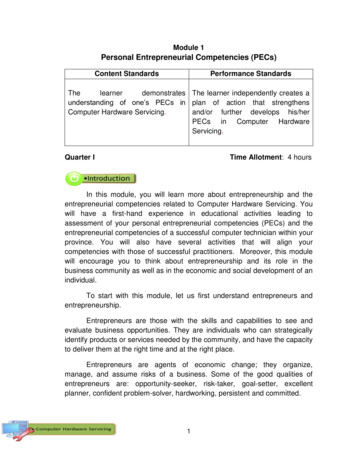
Transcription
Module 1Personal Entrepreneurial Competencies (PECs)Content StandardsPerformance StandardsThelearnerdemonstrates The learner independently creates aunderstanding of one’s PECs in plan of action that strengthensComputer Hardware Servicing.and/or further develops his/herPECs in Computer HardwareServicing.Quarter ITime Allotment: 4 hoursIn this module, you will learn more about entrepreneurship and theentrepreneurial competencies related to Computer Hardware Servicing. Youwill have a first-hand experience in educational activities leading toassessment of your personal entrepreneurial competencies (PECs) and theentrepreneurial competencies of a successful computer technician within yourprovince. You will also have several activities that will align yourcompetencies with those of successful practitioners. Moreover, this modulewill encourage you to think about entrepreneurship and its role in thebusiness community as well as in the economic and social development of anindividual.To start with this module, let us first understand entrepreneurs andentrepreneurship.Entrepreneurs are those with the skills and capabilities to see andevaluate business opportunities. They are individuals who can strategicallyidentify products or services needed by the community, and have the capacityto deliver them at the right time and at the right place.Entrepreneurs are agents of economic change; they organize,manage, and assume risks of a business. Some of the good qualities ofentrepreneurs are: opportunity-seeker, risk-taker, goal-setter, excellentplanner, confident problem-solver, hardworking, persistent and committed.1
Entrepreneurship, on the other hand, is not just a simple businessactivity but a strategic process of innovation and new product creation.Basically, entrepreneurship is both an art and science of converting businessideas into marketable products or services to improve the quality of living.Now that you have background knowledge about entrepreneurs andentrepreneurship, you can now walk through in assessing your PECs. Alwaysremember that successful entrepreneurs continuously develop and improvetheir PECs.To begin, let us find out the competencies you will have gained uponcompletion of this module.assessmentObjectivesAt the end of this module, you are expected to: identify areas for improvement, development, and growth,align your PECs according to your business or career choice, andcreate a plan of action that ensures success in your business or careerchoice.Now try to take the first challenge in this module, the pre assessment.Pre-assessmentAs part of your initial activity, try to assess your prior knowledge andexperience related to personal entrepreneurial competencies. Answer Task 1.Task 1: Matching TypeDirections: Match the entrepreneurial competencies in column A with theirmeaning in column B. Write the letter of the correct answer on the spaceprovided before each number.AB1. CreativeA. makes wise decisions towards the setobjectives2. Profit-orientedB. strategic thinking and setting of goals3. DisciplinedC. trusting in one’s ability2
4. Sound decision makerD. adoptable to change5. Possess people skillsE. innovates to have an edge over othercompetitors6. Excellent PlannerF. solid dedication7. ConfidentG. skillful in record keeping8. HardworkingH. always sticks to the plan9. Ability to accept changeI. work diligently10. CommittedJ. effective and efficient communicationskills and relates well to peopleK. always looking for an opportunity tohave/earn income.Task 2: Guide QuestionsDirections: The following are guide questions which covers the entiremodule. Write your answers on your assignment notebook. Discuss / sharethese to the class.A. Explain why entrepreneurial activities are important to socialdevelopment and economy progress.B. What entrepreneurial activities related to Computer HardwareServicing do you know and are capable of doing?C. If you were given the opportunity to own a business that relates toComputer Hardware Servicing, do you think you will be confident tomanage it? Explain your answer.D. What do you think are the most important competencies one mustpossess in order to be successful in running a chosen business?E. Name successful entrepreneurs from your province whose businessesare related to Computer Hardware Servicing. Make sure you will beable to share with the class the PECs that made them successful.3
After all the guide questions are answered, share these with yourclassmates. You may also compare your insigths, personal knowledge,and relevant experiences on the topic to make the sharing more excitingand engaging.Learning Goals and TargetsAfter understanding the objectives of this module, having gone throughpre-assessment, and answering the guide questions, you will be asked to setyour own personal goals and targets. These goals and targets will urge you tofurther achieve the ultimate objective of this module. In the end, theseultimate goals will motivate you to learn more about PECs.Goals andTargetsLearningActivitiesUltimate GoalFigure 1: Strategic process to achieve the objectives of this moduleReading Resources and Instructional ActivitiesAfter setting your own personal goals and targets in achieving theobjectives of this module, check your inherent knowledge of PECs. Answerthe following guide questions with the help of your classmates.Task 3: Group ActivityDirections: Answer the following guide questions on a separate sheet ofpaper. Share your answers with the class.1. Explain the importance of assessing one’s PECs before engaging in aparticular entrepreneurial activity.4
2. Are there other strategies or approaches where you can assess yourPECs? Explain how these strategies will become more useful inselecting a viable business venture.3. What are the desirable personal characteristics, attributes, lifestyles,skills, and traits of a prospective entrepreneur? Why are theseimportant?.4. Why is there a need to assess one’s PECs in terms of characteristics,attributes, lifestyles, skills, and traits before starting a particularbusiness?.5. What is the significance of evaluating PECs of a successfulentrepreneur? What helpful insights can you draw from this activity?.How was your experience in answering the guide questions with yourclassmates? Were you able to benefit from them? What were the insights youhave realized?This time you’re going to study the different topics that will enrich yourknowledge of PECs. Read all the important details about the succeedingtopic carefully.5
Assessment of Personal Entrepreneurial Competencies (PECs) andSkills vis-à-vis a Practicing Entrepreneur in a ProvinceEntrepreneurial competencies refer to the important characteristics thatshould be possessed by an individual in order to perform entrepreneurialfunctions effectively. In this module, you will learn some of the most importantcharacteristics, attributes, lifestyle, skills and traits of a successfulentrepreneur or an employee to be successful in a chosen career.Below are few important characteristics / traits / attributes of a goodentrepreneur: Hardworking: One of the important characteristics of a goodentrepreneur is hardworking. This means working diligently andbeing consistent about it. Hardworking people keep improving theirperformance to produce good products and/or provide goodservices. Confident: Entrepreneurs have self-reliance in one’s ability andjudgment. They exhibit self-confidence to cope with the risks ofoperating their own business. Disciplined: Successful entrepreneurs always stick to the planand fight the temptation to do what is unimportant. Committed: Good entrepreneurs assume full responsibility overtheir business. They give full commitment and solid dedication tomake the business successful. Ability to accept change: Nothing is permanent but change.Change occurs frequently. When you own a business, you shouldcope with and thrive on changes. Capitalize on positive changesto make your business grow. Creative: An entrepreneur should be creative and innovative tostay in the business and in order to have an edge over the othercompetitors.6
Has the initiative: An entrepreneur takes the initiative. You mustput yourself in a position where you are responsible for the failureor success of your business. Profit-oriented: An entrepreneur enters the world of business togenerate profit or additional income. The business shall becomeyour bread and butter. Therefore, you must see to it that thebusiness can generate income.Listed below are the important skills of a successful entrepreneur: Excellent planner: Planning involves strategic thinking and goalsetting to achieve objectives by carefully maximizing all theavailable resources. A good entrepreneur develops and follows thesteps in the plans diligently to realize goals. A good entrepreneurknows that planning is an effective skill only when combined withaction. Possesses people skills: This is a very important skill needed tobe successful in any kind of business. People skills refer toeffective and efficient communication and establishing goodrelationship to the people working in and out of your business. Inday-to-day business transactions, you need to deal with people. Awell-developed interpersonal skill can make a huge differencebetween success and failure of the business. Sound decision maker: Successful entrepreneurs have the abilityto think quickly and to make wise decisions towards apre-determined set of objectives. No one can deny that the abilityto make wise decisions is an important skill that an entrepreneurshould possess. Sound decisions should be based on given factsand information and lead towards the pre-determined objectives.To firm up what you have learned and have a better appreciation of thedifferent entrepreneurial competencies, read the PECs checklist below, thenanswer the same.7
Task 4: PECs ChecklistDirections: Using the PECs checklist, assess yourself by putting a check( ) mark in either strengths or development areas column. Interpret theresults by counting the total number of check marks in each of the columns.After accomplishing the checklist, form a group and share your insights on theresult of the personal assessment.Table 1: PECs ChecklistPersonal Assessment in termsof:Personal Entrepreneurial Competencies(PECs) of an EntrepreneurHardworking- Works diligentlyConfident- Self-reliance in one’s abilityDisciplined- Always stick to the planCommitted- Solid dedicationAbility to accept changes- AdaptableCreative- Innovative to have edge over othercompetitorsProfit-oriented- Always looking for an opportunity tohave/earn incomeExcellent planner- Strategic thinking and setting ofgoals8StrengthsDevelopmentAreas
Possess people skill- Effective and efficient communicationskills and relates well to peopleSound decision maker- Makes wise decisions towards theset objectivesTOTALInterpretation or Insight:.How was your experience in discovering the strengths and the areasyou need to develop? Did you gain a valuable experience in exchanginginsights with your classmates? To learn more and deepen your understandingof PECs, do task 5 below.Task 5: InterviewDirections: In your province, interview a successful computer technician orentrepreneur whose type of business is related with computer hardwareservicing. Focus your questions on PECs and other business-relatedattributes that helped them become successful. Analyze the results of theinterview and reflect on the similarities and/or differences. Write your answeron a separate sheet of paper.9
Sample Interview GuideName of Proprietor/Practitioner:Age: Number of Years in Business:Business Name:Business Address:1. What preparations did you make before you engaged in this type ofbusiness or job?.2. What special skills and characteristics do you have that are relatedwith your business or job?.3. How did you solve business-related problems during the early years ofyour business operation?.4. Did you follow the tips from a successful businessman or practitionerbefore you engaged in your business?.5. What best business practices can you share with aspiringentrepreneurs?.6. What do you think are the salient characteristics, attributes, lifestyle,skills and traits that made you successful in your business or job?.10
Directions: Copy the tables below in your notebook or in a separate sheet ofpaper. Gather the needed information from the interview to supply answer/sto row 1 in the table below, after which, fill out the second row with lEntrepreneur inthe provinceMy PECsUsing the information on the table above, analyze and reflect on thesimilarities and differences in your answers. Put your reflection on the tableyou copied in your notebook or in a separate sheet of paper. Write yourconclusion on the space its11Differences
Conclusion:.After performing the activities on the importance of PECs, let’sdetermine how much you have learned. Perform task 6 to determine how wellyou have understood the lesson.Task 6: Preparation of a Plan of ActionDirections: Use in a separate sheet of paper / in your notebook theinformation generated from task 5 (Interview) and prepare an action plan thatindicates alignment of your PECs to the PECs of a successful entrepreneur incomputer hardware servicing in your province.ObjectiveAreaActivitiesTo align my CharacteristicsPECs withthe PECs ofa successfulentrepreneurin Computer TimeFrameExpectedOutcome
Task 7: Essential QuestionsDirections: Read and study the following questions below. You may use aseparate sheet of paper or your notebook to write your answers.1. Why is there a need to compare and align one’s PECs with the PECsof a successful entrepreneur?.2. How does your action plan help sustain your strong PECs and/oraddress your development areas?.3. What plan of action will you utilize to address your development areas?.13
Module 2ENVIRONMENT AND MARKET (EM)Content StandardsPerformance StandardsThelearnerdemonstratesunderstanding of environment andmarket in Computer HardwareServicing in one’s province.The learner independently creates abusiness vicinity map reflective ofpotential market in ComputerHardware Servicing in a province.Quarter ITime Allotment: 4 hoursAspiring entrepreneur need to explore the economic, cultural, andsocial conditions prevailing in an area. Needs and wants of the people in acertain area that are not met may be considered business opportunities.Identifying the needs of the community, its resources, available raw materials,skills, and appropriate technology can help a new entrepreneur seizebusiness opportunities.To be successful in any kind of business venture, potentialentrepreneurs should look closely at the environment and market. Theyshould always be watchful of existing opportunities and constraints, and totake calculated risks. The opportunities in the business environment arefactors that provide possibilities for a business to expand and make moreprofit. Constraints, on the other hand, are factors that limit business growth,hence reduce the chance of generating profit. One of the best ways toevaluate opportunities and constraints is to conduct a Strengths,Weaknesses, Opportunities and Threats (SWOT) Analysis.SWOT Analysis is a managerial tool used to assess the environment. Itis used to gather important information which is then used in strategicplanning. Strengths and weaknesses are internal in an organization. Theyrelate to resources owned by an organization that you have control over andalso the extent of its marketing.14
Opportunities and threats exist in the external environment.Opportunities relate to the market, new technologies, and the external factorssuch as government policies, climate, and trends. Threats replace what thecompetitors are doing. It also includes legal and other constraints.Now that you have read some important considerations to explore tobe successful in any business, you are now ready to explore more about theenvironment and market.To begin with, let’s find out the competencies that you will master asyou finish this module.ObjectivesAt the end of this module, you are expected to: identify what is of “value” to the customer,identify the customer to sell to,explain what makes a product unique and competitive,apply creativity and innovative techniques to develop marketableproducts, andemploy a unique selling proposition (USP) to a product and/orservice.Now that you have an idea about the things you will learn, take the firstchallenge in this module – the pre-assessment.PreTask 1: Multiple ChoiceDIRECTIONS: Choose the letter of the best answer. Write your answer on aseparate sheet of paper.1. It is generated by examining the goods and services sold in thecommunity.A. business creationC. business conceptB. business pricingD. business idea2. It is a process of making new products which will be sold to thecustomers.15
A. product analysis3.4.5.6.7.C. productdevelopmentB. product conceptualizationD. productimplementationThese are luxuries, advantages and desires that every individualconsiders beyond necessary.A. wantsC. requirementsB. desiresD. needsIt is a factor or consideration presented by a seller as the reason that aproduct or service is different from and better than that of thecompetition.A. unique selling planC. unique pricingpolicyB. unique selling propositionD. finding value-addedA stage in which the needs of the target market are identified,reviewed, and evaluated.A. concept developmentC. project developmentB. economic analysisD. refine specificationIt is the introduction of new ideas to make the product and servicesmore attractive and saleable to the target customers.A. new ideaC. product developmentB. creativityD. innovationIt is a managerial tool used to assess the environment and to gatherimportant information that can be used for strategic planning.A. scanningC. WOTS AnalysisB. SWOT AnalysisD. survey analysis8. It is creating names, symbol, or designs that identifies anddifferentiates a product from the other products.A. product namingC. brandingB. unique selling propositionD. tagline9. It is a meaningful and unforgettable statement that captures theessence of the brand.A. product namingC. brandingB. unique selling propositionD. tagline10. These are things that people cannot live without.A. wantsC. requirementsB. desiresD. needs16
Task 2: Guide Questions:Directions: Read and study the guide questions below. Use a separatesheet of paper to write your answer.1. How does one determine the product or services to be producedand/or to be provided to the target customers?2. How does one select an entrepreneurial activity?3. When can one say that a certain product has “value?”4. Does applying creativity to your product or services important? Why?5. How can one effectively respond to the needs of the target customer?6. From the viewpoint of business owner, discuss the importance ofscanning the environment and market in generating business ideas.17
7. Using self-assessment, explain the level of your confidence informulating a business idea.After all the guide questions are answered and skills have beenmastered, share insights/ideas with your classmates. Discuss your insights,personal knowledge, and relevant experiences on the topic to make it moreexciting and engaging.Learning Goals and TargetAfter reading and understanding the objectives of this module andhaving gone through the pre-assessment and guide questions, you will beasked to set your own personal goals. These goals will urge you to furtherachieve the ultimate objective of this module. In the end, these goals willmotivate you to learn more about environment and market.Goals andTargetsLearningActivitiesUltimate GoalFigure 2: Strategic process to reach the objectives of this module18
After setting your own personal goals and targets in achieving theobjectives of this module, you will have the opportunity to read and learnmore about environment and market. You will also be given a chance to dopractical exercises and activities to deepen your understanding of the topic.Product DevelopmentWhen we talk of product development, we are referring to a process ofmaking a new product to be sold by a business or enterprise to its customers.Product development may involve modification of an existing product orits presentation, or formulation of an entirely new product that satisfies anewly-defined customer’s needs, wants and/or a market place.The term development in this module refers collectively to the entireprocess of identifying a market opportunity, creating a product to appeal tothe identified market, and testing, modifying, and refining the product until itbecomes ready for production.There are basic, yet vital questions that you can ask yourself aboutproduct development. When you find acceptable answers to them, you maynow say that you are ready to develop a product and/or render services.These questions include the following:1.2.3.For whom are the product/services aimed at?What benefit will the customers expect from product/service?How will the product/service differ from the existing brand? Fromits competitor?In addition, needs and wants of the people within an area should alsobe taken into big consideration. Everyone has his/her own needs and wants.However, each person has different concepts of needs and wants. Needs inbusiness are the important things that an individual cannot live without in asociety. These include:1.2.3.4.basic commodities for consumption,clothing and other personal belongings,shelter, sanitation and health, andeducation.19
Basic needs are essential to an individual to live with dignity and pridein a community. These needs can obviously help you generate businessideas and subsequently to product development.Wants are desires, luxury and extravagance that signify wealth andexpensive way of living. Wants or desires are considered above all the basicnecessities of life. Some examples of wants or desires are: fashionaccessories, expensive shoes and clothes, travels, eating in an expensiverestaurant, watching movies, concerts, having luxurious cars, wearingexpensive jewelry and perfume, living in impressive homes, among others.Needs and wants of people are the basic indicators of the kind ofbusiness that you may engage in because it can serve as the measure ofyour success. Some other points that might be considered in businessundertakings are the kind of people, their needs, wants, lifestyle, culture andtradition, and their social orientation.To summarize, product development entirely depends on the needsand wants of the customers. Another important issue to deal with is the keyconcepts of developing a product. The succeeding topic shall enlighten youabout the procedure in coming up with a product.Concepts of Developing a ProductConcept development is a critical phase in the development of aproduct. In this stage, the needs of the target market are identified, andcompetitive products are reviewed before the product specifications aredefined. The product concept is selected along with an economic analysis tocome up with an outline of how a product is being developed. Figure 3 showsthe stages of concept development of a product.20
elect lopmentFigure 3: Stages of Concept DevelopmentThe process of product development follows the following stages:1. Identify customer needs: Using survey forms, interviews, researches,focus group discussions, and observations, an entrepreneur can easilyidentify customers’ needs and wants. In this stage, the information thatcan be possibly gathered are product specifications (performance, taste,size, color, shape, life span of the product, etc.). This stage is veryimportant because it would determine the product to be produced orprovided.2. Establish target specifications: Based on customers' needs andreviews of competitive products, you can now establish targetspecifications of the prospective new product and/or services. A targetspecification is essentially a wish-list.3. Analyze competitive products: It is imperative to analyze existingcompetitive products to provide important information in establishingproduct or service specifications. Other products may exhibit successfuldesign attributes that should be emulated or improved upon in the newproduct or service.4. Generate product concepts: After having gone through with theprevious processes, you may now develop a number of product21
concepts to illustrate the types of products or services that aretechnically feasible and will best meet the requirements of the targetspecifications.5. Select a product concept: Through the process of evaluation betweenattributes, a final concept is selected. After the final selection, additionalmarket research can be applied to obtain feedback from certain keycustomers.6. Refine product specifications: In this stage, product or servicesspecifications are refined on the basis of input from the foregoingactivities. Final specifications are the result of extensive study, expectedservice life, projected selling price among others are being considered inthis stage.7. Perform economic analysis: Throughout the process of productdevelopment, it is very important to always review and estimate theeconomic implications regarding development expenses, manufacturingcosts, and selling price of the product or services to be offered orprovided.8. Plan the remaining development project: In this final stage of conceptdevelopment, you can prepare a detailed development plan whichincludes list of activities, necessary resources and expenses, anddevelopment schedule with milestones for tracking progress.Finding ValuePeople buy for a reason. There should be something in your product orservice that would give consumers a good reason to go back and buy more.There must be something that will make you the best option for targetcustomers; otherwise, they have no reason to buy what you are selling. Thisimplies further, that you offer something to your customers that will makethem value your product or service.The value you incorporate in your product is called value proposition.Value proposition is a believable collection of the most persuasive reasonswhy people should notice you and take the action you’re asking for. It is whatgets people moving, what makes people spend for your product or service.22
InnovationInnovation is the introduction of something new in your product orservice. This may be a new idea, a new method, or a new device. If you wantto increase your sales and profit, you must innovate. Some of the possibleinnovations for your products are change of packaging, improvement of taste,color, size, shape, and perhaps price. Some of the possible innovations inproviding services are application of new and improved methods, additionalfeatured services, and possibly freebies.Unique Selling Proposition (USP)Unique Selling Proposition is the factor or consideration presented by aseller as the reason that one product or service is different from and betterthan that of the competition. Before you can begin to sell your product orservice to your target customers, you have to sell yourself in it. This isespecially important when your product or service is similar to yourcompetitors.USP requires careful analysis of other businesses' ads and marketingmessages. If you analyze what they say or what they sell, not just theirproduct or service characteristics, you can learn a great deal about howcompanies distinguish themselves from competitors.Here's how to discover your USP and how to use it to increase your sales andprofit: Use empathy: Put yourself in the shoes of your customers. Alwaysfocus on the needs of the target customers and forget falling in lovewith your own product or service. Always remember, you aremaking/providing this product not for yourself but for the targetcustomers to eventually increase sales and earn profit. Essentialquestion such as what could make them come back and ignorecompetition, should be asked to oneself. Most possible answers maybe focused on quality, availability, convenience, cleanliness, andreliability of the product or service. Identify customer’s desires. It is very important for you to understandand find out what drives and motivates your customers to buy yourproduct or service. Make some effort to find out, analyze and utilize theinformation that motivates the customers in their decision to purchasethe product or service.23
Discover customer’s genuine reasons for buying the product.Information is very important in decision making. A competitiveentrepreneur always improve their products or services to providesatisfaction and of course retention of customers. As your businessgrows, you should always consider the process of asking yourcustomers important information and questions that you can use toimprove your product or service.To enhance your understanding of the topic previously presented, youwill be tasked to form a group and arrange an interview with a successfulentrepreneur or practitioner. You have to document this interview and presentthis to the whole class for reflection and appreciation.Task 3: InterviewDirections: Select a successful entrepreneur or practitioner. Conduct aninterview using the set of questions below. Document the interview andpresent it to the class. Use a separate sheet of paper.1. How did you identify your customers?2. What were your considerations in selecting your customers?3. Explain how your product or service became unique to other produ
create a plan of action that ensures success in your business or career choice. Now try to take the first challenge in this module, the pre assessment. As part of your initial activity, try to assess your prior knowledge and experience related to personal entrepreneurial
